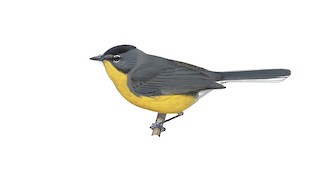
Saffron-breasted Redstart Myioborus cardonai Scientific name definitions
- NT Near Threatened
- Names (22)
- Monotypic
Text last updated November 28, 2013
Sign in to see your badges
Species names in all available languages
| Language | Common name |
|---|---|
| Bulgarian | Гуайкинимско червеноопашато коприварче |
| Catalan | bosquerola de Cardona |
| Croatian | bolivarska sjeničica |
| Dutch | Cardonazanger |
| English | Saffron-breasted Redstart |
| English (United States) | Saffron-breasted Redstart |
| Estonian | tõmmu-mägisäälik |
| French | Paruline de Cardona |
| French (Canada) | Paruline de Cardona |
| German | Guaiquinimawaldsänger |
| Japanese | キムネアメリカムシクイ |
| Norwegian | guaiquinimahvitstjert |
| Polish | pleszówka szafranowa |
| Russian | Серощёкая канделита |
| Serbian | Šafranasta američka crvenrepka |
| Slovak | horárik štvorfarebný |
| Spanish | Candelita de Cardona |
| Spanish (Spain) | Candelita de Cardona |
| Spanish (Venezuela) | Candelita de Cardona |
| Swedish | guaiquinimavitstjärt |
| Turkish | Sarı Göğüslü Ötleğen |
| Ukrainian | Чернітка шафранова |
Myioborus cardonai Zimmer & Phelps, 1945
Definitions
- MYIOBORUS
- cardonai / cardonaorum
The Key to Scientific Names
Legend Overview
Introduction
The Saffron-breasted Redstart is a very rare Venezuelan endemic warbler with a tiny range. Restricted entirely to cloud forest between 1200 and 1600 meters in elevation on Cerro Guaiquinima in Bolivar, Venezuela, the species is considered only "near threatened" by the IUCN Red List because of the extremely remote nature of the range and the limited ongoing impact of human activity in the region. The species is olive-gray above with a black crown, white throat and eyering, orange-yellow underparts, and black tail with white outer rectrices. Due to its limited range, the species is alternatively called "Guiaquinima Redstart" or "Guiaquinima Whitestart".
Field Identification
13 cm. Has forehead and crown solid black, face and upperparts slate-grey, white eye-crescents; tail black, extensive white in outer rectrices; throat and underparts deep orange-yellow, white undertail-coverts; iris dark; bill and legs blackish. Differs from similar M. albifacies only in having dark grey, not white, face. Sexes similar. Juvenile undescribed.
Systematics History
Subspecies
Distribution
Cerro Guaiquinima (C Bolívar), in EC Venezuela.
Habitat
Humid cloudforest, forest edge, gallery forest and dense scrub, at 1200–1600 m.
Movement
Presumably sedentary.
Diet and Foraging
No information.
Sounds and Vocal Behavior
Song is a musical, high-pitched rapid, warble swelling in volume. Typically a duet, one bird a rising almost hissing song, the other bird a more melodious rising and falling warble. Call is a high-pitched "tsik".
Breeding
No information.
Conservation Status
Not globally threatened. Currently considered Near-threatened. Restricted-range species: present in Tepuis EBA. Has tiny global range; estimated 500–600 km2 of suitable habitat on Cerro Guaiquinima, within which this species is described as being common. Although there has been mining for many years at base of the mountain, this thought not to have had significant impact, and no agriculture within the species' range. In addition, wet climate and large river valleys surrounding the mountain make loss of habitat through fire fairly unlikely.

- Year-round
- Migration
- Breeding
- Non-Breeding







































